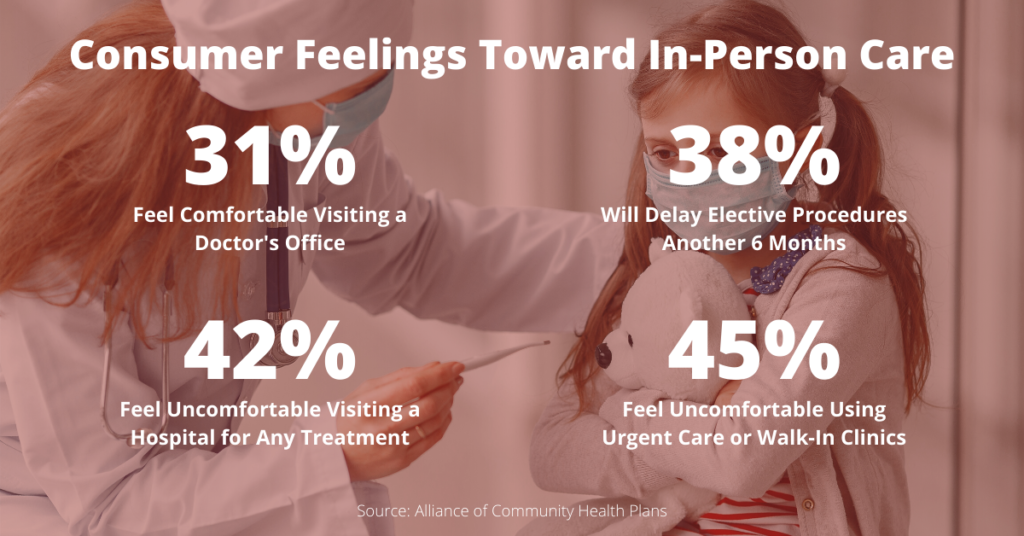The COVID-19 pandemic has affected every industry, especially healthcare. Even as states begin lifting restrictions, “normal” seems a long way away. What we know as normal may even be a thing of the past. While some changes may be temporary, the pandemic has brought about permanent ones that are reshaping the future of healthcare. Some of these changes are long overdue. So what does the future look like, and how can providers navigate this new normal? Let’s look at the first step, assuring patients that it’s safe to come back, then we’ll discuss how hospitals can begin recapturing lost revenue, and finally, we’ll tie it all together to discuss how providers can focus on the future.
Fighting Patients’ Fears
The first step to navigating the new normal in healthcare is getting patients back. As shutdowns began in March, hospitals utilized telehealth visits and canceled elective procedures to reduce the risk of patient infections and divert resources to caring for COVID-19 patients. But even as hospitals are giving patients the green light to return for in-person care, many patients are still cautious. A national survey released on May 21 by the Alliance of Community Health Plans (ACHP) and AMCP shows that only 31 percent of respondents feel comfortable returning to the doctor’s office. Additionally, 42 and 45 percent respectively were uncomfortable visiting a hospital for any medical treatment and using urgent care or walk-in clinics.
While the current climate already has patients wary about seeking in-person treatment, fear of a 2nd wave of coronavirus in the fall or winter led 38 percent of respondents to say they would delay elective procedures for another six months. While further delays can result in continued revenue loss for hospitals, they can also jeopardize patients’ health. That’s why it’s important for providers to reassure patients by providing a clean and safe environment and coming to them when possible. For example, in addition to continued telehealth visits, Cedars-Sinai has implemented at-home colon cancer screenings.

Recovering Revenue
By addressing patients’ fears, providers can take the first steps toward revenue recovery. While elective procedures will still make up much of hospitals’ revenue, the future of healthcare presents more avenues of generating income. However, it also requires adaptation on the part of providers.
Elective Procedures
As hospitals across the country resume elective procedures, it’s vital to adapt procedures to the COVID-19 environment. First, hospitals should determine which procedures should be prioritized and which are safe to be further postponed. For instance, University of Kentucky surgeon Dr. Prakash Pandalai said his team is prioritizing procedures for cancer treatment and preventing the loss of limb or disease acceleration. Similarly, Dr. Andrew Ibrahim of the University of Michigan stated his hospital has established a committee to determine procedure prioritization.
Dr. Pandalai also reiterated the need for PPE considerations. When determining when to resume elective procedures and the volume they can perform, hospitals should ensure they have adequate PPE stockpiles for staff treating COVID-19 patients, especially in the event of a resurgence. In addition to purchasing additional PPE, hospitals can also conserve equipment by administering COVID-19 tests to patients 72 to 96 hours before a scheduled surgery and by continued use of telehealth, which leads to our next point.
Telehealth
While the use of telehealth had been slowly growing the past several years, the COVID-19 pandemic thrust it into the forefront of the medical field. Both patients and providers who had previously been reluctant to try virtual visits have been forced to give telehealth a shot. In fact, NYU Langone saw a 4,345% increase in non-urgent virtual visits between March 2 and April 14, and MedStar Health recorded over 100,000 virtual visits from March 13 to May 1. Furthermore, Frost & Sullivan predicts 38.2% compound annual growth rate in telehealth visits by the year 2025. While telehealth is a great tool to use during the pandemic, it seems poised to be a mainstay in the future of healthcare and presents a great revenue opportunity for providers.
Value-Based Care
The COVID-19 pandemic has also put a greater focus on value-based care, a philosophy that seeks to keep people healthy and prevent chronic health problems, rather than waiting for them to get sick and treating them then. By keeping patients healthy and better managing chronic diseases, providers can ensure better outcomes for patients and increase patient loyalty, which carries a host of benefits itself. Some of the ways providers can prioritize value-based care include incorporating (or continuing) telehealth for improved at-home care and implementing medical order management software with integrated clinical decision support, such as iOrder, to improve ambulatory care.
Focusing on the Future
In this new normal, the future of healthcare is already upon us. In a matter of weeks and months, the healthcare industry has been forced to adapt and adopt new practices that seemed years away from widespread application. They did so all the while experiencing record financial losses. Now that lockdown restrictions are being lifted, hospitals hope to see revenues begin trending upward again.
For this to happen however, providers must first address the public’s fears about seeking in-person care while the pandemic still rages. While this may be challenging, many of the protocols hospitals have already implemented to prioritize safety during the pandemic should be reassuring to patients. Some new practices, such as telehealth, also have economic benefits beyond the pandemic, opening up new revenue opportunities. The future of healthcare is also likely to see a shift to value-based care to provide better outcomes for patients. At iPro, we’ve been helping providers improve patient care for over 20 years. If you’d like to learn more about how our medical order management software can help you prosper in the present and prepare for the future, contact us.




